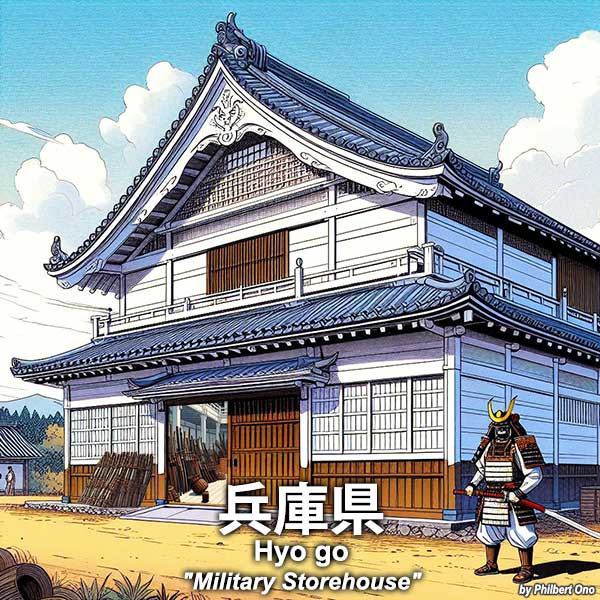HYOGO – Military Storehouse 兵庫県

Not much is known about how and why the “Hyogo” name came about. There’s only speculation and a few theories.
Theory 1: During the Taika Reforms in 645 when the Imperial Court expanded their authority, the Settsu Checkpoint (摂津の関) in Suma (west of Kobe Port) and three other security checkpoints (Ise-Suzuka, Mino-Fuwa, Echizen-Arachi) in the Kansai Region were built to screen travelers along the main roads and protect the Imperial Palace in Kyoto against undesirable people.
Near the Settsu Checkpoint in Suma, an Imperial military weapons storehouse (armory or arsenal) called “Tsuwamono-gura” (兵庫, now pronounced “Hyogo”) may have been built to protect the checkpoint.
The exact location and exterior appearance of this storehouse and the Settsu Checkpoint remain unknown. It was during the reign of Emperor Tenji (天智天皇) in 668–672.
In the late 19th century though, a pillar suspected of being part of the Settsu Checkpoint was excavated near Genko Temple (現光寺) in Suma. There’s a monument indicating the checkpoint’s possible location. These checkpoints were abolished by 789.
Theory 2: The earliest known document where “Hyogo” appears is in a Kujo Clan document dated 1105 called the “Tachibana Tsuneto land donation letter” (橘経遠寄進状). It mentions Hyogo-sho manor (兵庫庄), an estate near an important port named Owada-no-Tomari (大輪田泊) which was later renamed “Hyogo-zu” or “Hyogo-no-tsu” Port (兵庫津) during the Kamakura Period.
Hyogo-zu Port was important for trade with Song China. It became more important when Japan opened to American ships in January 1868. Kobe Port, which opened anew to foreign trade, was actually slightly east of Hyogo-zu Port.
In the bustling Hyogo-Kobe port area, the new Meiji government placed a local government office (兵庫鎮台) in 1868 to supervise international port operations. This local government was soon renamed Hyogo Prefecture on May 23, 1868 after the name of district where the port was located.
Following mergers of smaller prefectures into the original Hyogo Prefecture, the Hyogo Prefecture we know today was finally established in August 1876. The old Hyogo-zu Port is now part of Kobe Port which remains one of Japan’s largest international ports.
Old province names: Harima-no-Kuni, Tajima-no-Kuni, Settsu-no-Kuni, Tanba-no-Kuni, Awaji-no-Kuni (播磨国+但馬国+摂津国+丹波国+淡路国)
*The AI-generated image is for illustrative purposes only and may not accurately depict any particular place in the prefecture.
Sources: https://www.kkr.mlit.go.jp/hyogo/kankou/michi/yurai/index.html
https://www.hyogo-c.ed.jp/~rekihaku-bo/historystation/rekihaku-meet/q-and-a/index.html
https://web.pref.hyogo.lg.jp/kk32/pa13_000000023.html
http://about.sumaura.jp/e368994.html
Origin of other prefectural names (etymologies)
Overview | Aichi | Akita | Aomori | Chiba | Ehime | Fukui | Fukuoka | Fukushima | Gifu | Gunma | Hiroshima | Hokkaido | Hyogo | Ibaraki | Ishikawa | Iwate | Kagawa | Kagoshima | Kanagawa | Kochi | Kumamoto | Kyoto | Mie | Miyagi | Miyazaki | Nagano | Nagasaki | Nara | Niigata | Oita | Okayama | Okinawa | Osaka | Saga | Saitama | Shiga | Shimane | Shizuoka | Tochigi | Tokushima | Tokyo | Tottori | Toyama | Wakayama | Yamagata | Yamaguchi | Yamanashi